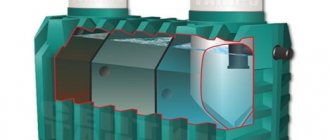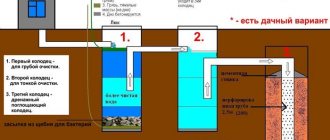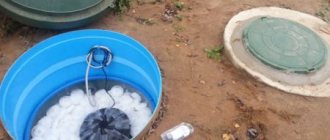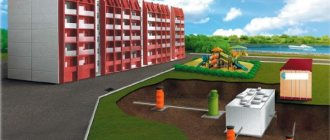Many fully equipped houses built outside the city limits do not have a centralized sewerage system, so in order to dispose of wastewater from a private home, it becomes necessary to build a septic tank or shambo. The last option is inexpensive and quite effective. This is a specially designed sealed cesspool in which wastewater accumulates and is subsequently pumped out by sewer machines.
The following options are available for the device:
- installation of a ready-made metal or plastic container with the required volume for collecting and storing sewage. This is the simplest and fastest solution;
- construction of a prefabricated structure from reinforced concrete rings or rectangular blocks. Laying elements will require the use of lifting mechanisms;
- production of a monolithic structure in a pit with installation of formwork, reinforcement and pouring of concrete mixture. The design is reliable in operation, but labor-intensive and time-consuming to construct;
- brick execution. It will require a mandatory installation of high-quality waterproofing, which is not cheap.
How the system works
The Shambo device allows the installation of modern types of autonomous sewer systems for residential country houses. A supply pipe with a diameter of 100 mm is supplied to the reservoir located in the pit, which is laid in a trench with a slope from the house of 2 cm per linear meter. To prevent wastewater from freezing, pipes must be properly insulated.
If drainage occurs from household devices (sink, toilet, bathtub) located in the basement, there is a need to purchase special pumping units installed directly to sanitary fixtures. There are small-sized installations that ensure the simultaneous operation of several sanitary appliances (for example, a toilet and two washbasins).
This installation works as follows:
- grinding of waste entering it;
- The crushed mass, using a specially built-in pump, enters the sewer riser. Raising waste is provided to a height of up to 6 m;
- From the sewer riser, the wastewater moves through the drain pipe into a container under the shambo;
- Through a pipe connected to the ventilation system of the building, purified air is removed from the device.
The main container must have a sealed lid with a ventilation outlet and a discharge pipe for pumping out using a sewer truck. To determine when it is time to pump out, a float sensor with an alarm system is provided in the tank; when the specified level is reached, a light comes on.
Modern biological products designed for the effective processing of household waste and sewage create comfort and convenience of living in individual homes.
Installation
Creating a cesspool of this type is a simple process, which means you can handle it on your own. In general, it includes the following steps:
- Development of a pit two to three meters deep and approximately two meters in diameter;
- Creating a reservoir. This stage is determined by the type of container selected. The walls can be concreted, lined with bricks, and then sealed. Ready-made reinforced concrete rings are often used. In the latter case, the size of the pit is selected based on their diameter. When using reinforced concrete rings, the joints between them are additionally sealed and sealed. In such structures, concrete formwork or a finished reinforced concrete product is used as the bottom;
- Organization of ventilation and pumping pipe. If several tanks are used, they are connected to each other by pipe sections at the top and bottom;
- A pipeline is drawn from the house, which connects to a sewer riser on one side and a cesspool on the other. Pipes must be laid at an angle to ensure gravity flow.
Regulatory requirements for installing shambo
If ≥ 4 people permanently live in a heated country house, then the pit must be equipped with a bottom. If permanent residence is not planned and there are no household appliances in the house with high water consumption (total daily working volume of wastewater ≤ 1 m3), natural filtration is permissible, in which the reservoir is constructed with an open bottom.
The following indicators are standardized by sanitary regulations:
- the distance of the shambo from the house is ≥ 15 m, this is due to the neutralization of the effects of toxic gases released from waste waste during the process of their decomposition;
- pits without a bottom are located no closer than 30 m from water supply sources (wells, artesian wells); if there is a sealed bottom, this minimum distance can be reduced by 2 times. If there is no bottom in the pit, growing vegetables and food products in this area is not recommended;
- the distance of the shambo from the neighboring plot is ≥ 1.5 m, with the exception of cases of using a cesspool together with neighbors;
- the depth of the tank is ≤ 3 m, in order to ensure convenience and efficiency of pumping; hoses may simply not be accessible to greater depths;
- The extreme level of sewage pumping is located 35 cm below ground level.
What is a septic tank?
But a septic tank is not just a storage tank, but a treatment plant in which wastewater goes through several stages of purification. The septic tank works as follows:
- contaminated water flows through a pipeline into the first well, which is the primary settling tank. Here the heaviest inclusions are deposited;
- the overflow device is installed so that primary purified water enters the next chamber;
- in the second well, the clarified water continues to settle, such multi-stage settling provides better cleaning;
- the sediment that accumulates at the bottom undergoes fermentation processes; reactions occur without the supply of oxygen. As a result of biochemical processes, organic matter decomposes with the formation of water, methane (and a number of other gases) and insoluble sediment.
Advice! Periodically, approximately once a year, the sedimentation tanks will have to be cleaned of sediment accumulating at the bottom. If this is not done, the sediment will begin to compress, reducing the working volume of the chambers, which will result in the septic tank working worse.
- the water removed from the septic tank is directed to soil filtration, so the septic tank is built in conjunction with a filter well, filtration fields or irrigation domes.
Requirements
The requirements for installing a septic tank are even more stringent than for the construction of a septic tank. After all, a septic tank, unlike a storage tank, directs water to be discharged. Therefore, it is necessary to locate the installation away from residential and outbuildings, garden plants, roadways and fences with neighboring areas.
It is very important that the septic tanks have sufficient volume. Otherwise, the water will not have time to settle and the filtration fields will quickly become unusable due to silting of the filter layer. The optimal volume of the septic tank should be such as to accommodate the wastewater that forms in the house within three days, since it is in 72 hours that the water has time to settle well.
A mandatory condition for operation is the organization of ventilation of the septic tank, since during the fermentation of organic waste gaseous substances are formed that must be removed from the tanks.
Determining the required volume
Since the Shambo sewage system is of the export type, the storage tank must correspond to the volume accumulated for at least 2 weeks, this will allow you to save on expensive sewage disposal services. Volume calculation is carried out taking into account the following factors:
- the number of people living in the house, the estimated volume of water consumed per person is assumed to be 200 liters per day;
- use of bathtub, washing machine and dishwasher - 50 liters per day.
The optimal volumes are those that allow the sewer truck to perform one-time pumping.
Cleaning procedure
A sewer truck is called in to clean the Shambo tank; this need arises approximately once every two weeks. To ensure that this procedure is carried out less frequently, experts advise using a special septic tank, the effect of which helps to reduce the volume occupied by wastewater. In addition, it would be useful to use special products with a disinfecting effect that eliminate unpleasant odors. The use of drugs after the pumping procedure is especially important.
The drugs differ in the type of action, some only allow the decomposition of organic compounds, they will have to be used quite often, but they are also inexpensive. However, there are also substances on the market with special bacteria in their composition that are not afraid even of exposure to chlorine and detergents. They cost more, but they are also more effective.
Existing pros and cons
Present advantages, compared to conventional cesspools:
- environmental friendliness of the settling tank due to its absolute tightness preventing the leakage of contaminated water;
- ease of installation, allowing you to install a shambo with your own hands;
- possibility of installation in almost any soil with any permeability and high groundwater level;
- low material costs for construction;
- ease of maintenance during operation.
Disadvantages:
- the likelihood of unpleasant odors appearing, necessitating the use of special bacteriological preparations or the installation of a factory-made plastic container;
- periodic pumping of wastewater, the frequency can be reduced by means that accelerate the decomposition of organic residues.
Comparative characteristics
Let's compare installations for local sewerage:
- Construction. Of course, it will be much easier to build a shambo than a septic tank. After all, the drive consists of only one, fairly capacious container. To build a septic tank, you will need to construct several wells (or build one container separated by partitions), connected by overflow devices.
- Environmental Safety. From an environmental point of view, Shambo is an impeccable option, since with proper construction of this structure, contaminated liquid cannot enter the ground, but liquid from the septic tank enters the ground. Moreover, the quality of treatment in settling tanks is not high enough, therefore, in order to ensure a sufficient level of environmental safety, it is necessary to use soil filtration.
- Service. It is enough to service the septic tank once a year. It is with this frequency that it will be necessary to pump out the sediment that accumulates at the bottom of the tanks, but the Shambo will have to be serviced more often. The drainage from it does not disappear anywhere, therefore, the more water is used in the house, the more often pumping will be necessary.
Advice! The services of vacuum cleaners who pump waste from storage tanks or septic tanks are by no means cheap. Therefore, if pumping is carried out frequently, this will lead to additional costs.
How to make shambo
After determining the installation location of the shambo in accordance with sanitary standards, the structure is installed. Let's consider the most commonly used installation option of reinforced concrete rings.
Scope of work:
- Development of a pit with a depth of 3 m, overall dimensions along the width of the rings with a reserve for the installation of subsequent waterproofing. Most often, rings with diameters of 100 or 200 cm are used. If the required volume is insufficient, two rows of rings can be laid. When you connect the two resulting columns with an overflow tube, you get a kind of chambeau septic tank.
- After carefully leveling the bottom of the pit, a 10 cm sand cushion is placed. After compacting the sand, the first ring with the bottom is laid. If this is not available, a layer of reinforced concrete is laid and the junction of the lower ring adjacent to the concrete is insulated to prevent drainage from seeping into the soil.
- Installing the bottom ring using a truck crane. It is recommended to select rings with existing grooves and a ridge, which ensures a tighter connection.
- The next ring is installed on the bottom ring on a layer of cement mortar with the addition of liquid glass. If there are no grooves, the connection is additionally fixed using metal plates or brackets. The installation of the remaining rings is carried out similarly.
- Insertion of a supply pipe into the well with sealing of the entry.
- Waterproofing the resulting well outside and inside.
- Backfilling a septic tank.
- The last ring can be purchased with a factory-made cover, which has a hatch with a plastic or cast iron cover. If such a ring has not been purchased, then the reinforced concrete cover with a hatch is mounted on a regular cement-sand mortar.
- Installation of ventilation pipe.
- Insulation of the lid.
After completing the work, you can begin testing the system and its further operation.
- Engineering Communication
Which option should I choose?
It is impossible to say unequivocally which method of wastewater disposal should be chosen. It is necessary to take into account the operating conditions. One of the most important factors influencing the choice is the amount of waste to be disposed of. If the volume is large, then it is better to install a septic tank, since the costs during the construction phase will be offset by the absence of the need to often use the services of sewer trucks.
With a small volume of wastewater, it makes sense to install a sealed storage tank. Its construction will cost less, and cleaning the tank, carried out once or twice a year, will have little impact on the family budget.
Another important point is the geological conditions at the site. The fact is that under difficult conditions (quicksand, clay soil, etc.) it is extremely difficult to build a septic tank, since it will be impossible to organize water drainage by soil filtration. In such conditions, it may be more profitable to install a sealed plastic tank, since the construction of a septic tank will be too expensive.
So, when building a local sewer system, it is very important to choose a simple, effective and inexpensive method for disposing of sewer wastewater. There is no single solution that will suit everyone without exception. To choose the best option, it is necessary to assess the operating conditions of the local sewerage system, as well as find out the main characteristics of the soil in the area where construction is planned. If water consumption is low, and if it is necessary to carry out construction in difficult geological conditions, it is more profitable to install Shambo. Otherwise, a septic tank will be the optimal solution.










